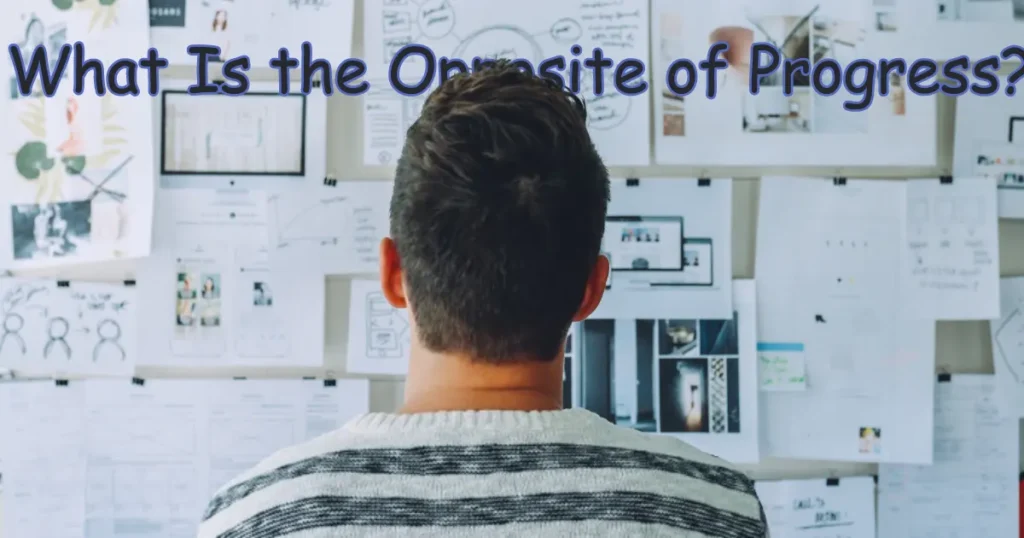Opposite of Progress: What Holds Us Back?

In our journey through life, we often talk about moving forward, improving things, and progressing. But sometimes, things don’t move forward – they stay still and go backward. That’s what we call the “Opposite of Progress,” So in this article, I’ll give you a simple guide to help you understand what exactly is the opposite of progress or what holds us back.
What Is the Opposite of Progress that Hold Us Back?
The opposite of progress is often characterized by stagnation or decline, reflecting situations where societal, economic, or personal growth is hindered. But by examining historical patterns that impede advancement, we can gain insights into what constitutes the antithesis of progress.
Regressing to the Past
- The opposite of progress involves a backward movement, characterized by elements such as regression, retrogression, or retroversion.
- One must delve into the historical context to comprehend this and understand the forces contributing to societal or technological setbacks.
- This backward journey unveils the intricacies of decline, highlighting how regression can impede advancement.
- Exploring societal shifts or technological downturns necessitates a nuanced examination of historical factors.
- Understanding why progress takes a step back requires identifying patterns and influences from the past.
- Whether examining societal norms or technological innovations, recognizing the forces leading to regression provides valuable insights into the opposite of progress.
Stagnation Amidst Change
- Stagnation, a hallmark of the opposite of progress, signifies a lack of movement or growth.
- This occurs when we strive for progress to a standstill, despite external pressures or opportunities for advancement.
- Identifying scenarios of stagnation involves a keen awareness of the absence of positive change amid evolving external factors.
- Picture a scenario where societal, economic, or personal development remains static despite the potential for improvement.
- Recognizing stagnation requires an understanding of the factors preventing growth.
- Whether it’s societal norms resisting change, or economic structures hindering progress.
- Or personal choices impeding development, stagnation stands as a roadblock to the forward momentum of progress.
Decline in Advancement
- In specific contexts, the opposite of progress manifests as a decline in societal, economic, or individual advancements.
- Recognizing this decline demands a sharp observation of indicators such as economic downturns, social regression, or diminishing technological capabilities.
- This decline serves as a critical marker of the forces obstructing progress.
- Observing societal well-being, economic stability, or personal growth, the signs of decline become apparent.
- Economic troubles manifest as downturns, social regression as increased unrest or inequality, and tech issues as setbacks in innovation.
- So identifying these indicators is crucial for understanding the multifaceted nature of the opposite of progress that holds us back.
- And the challenges that impede positive societal, economic, or personal development.
Words That Don’t Quite Fit for Finding the Opposite of Progress
Words That Miss the Point
- Okay, so when we’re talking about the opposite of progress, some words sound right, like stasis, inertia, or standstill.
- But here’s the deal—they might not show the whole picture. Sure, they say things aren’t moving.
- But they might not shout out that we’re actually going backward.
- It’s like having puzzle pieces that almost fit, but not really. Knowing these words’ limits is important if we want to get what’s really stopping progress.
- Think of it as saying things are on pause when they’re really sliding backward.
- These words have their uses, but for explaining why progress is stuck, they might not tell the full story.
- Being aware of these limits helps us understand what’s blocking progress better.
Or Words That Tell More
- Some words might seem easy, but when we’re talking about the opposite of progress, we need to be a bit careful.
- Using words that make things sound too easy can make it tricky to get what’s really happening.
- It’s like telling a story with just the main part and skipping the cool details.
- But avoiding words that make things too simple is important for diving deep into the mix of stuff like going backward, getting stuck, or things sliding down.
- Imagine explaining a favorite game, but instead of talking about all the fun levels, you just say, “You play and win.” Too simple, right?
- The opposite of progress that holds us back is a bit like that—full of twists and turns.
- Using words that show this mix helps us explore what’s happening without missing the interesting parts.
Words that Zoom In
- Choosing words is like picking the right tool. Some words seem like they work everywhere, but for the opposite of progress, we need to get specific.
- Using words that cover too much can make things a bit fuzzy. It’s like having a map that shows a big area but doesn’t point out the cool spots.
- Going for specifics is the trick – it helps us dig into the details of the things that are stopping progress.
- Think of it like talking about a favorite meal. If you just say it’s “food,” you miss all the tasty bits.
- The opposite of progress is a bit like that—using spot-on words helps us catch all the different parts of the challenge. It’s about being clear, so try to say what you mean.
Choosing the Right Words Matters in Exploring the Opposite of Progress
Knowing what these words mean helps us express exactly what kind of opposite-of-progress situation we’re talking about.
Pick the Right Words
- Regress: Imagine going backward, like taking a step back.
- Retrogress: Similar to regress, but maybe going back to an older or less advanced stage.
- Stagnate: Think of things just stopping, not moving forward.
- So, choosing the right word helps us talk about the opposite of progress in a specific way, whether it’s going backward, reverting to an old stage, or just not moving.
Understand what Words Mean
- Stagnation: Things are stuck, not going anywhere for a bit. It’s like hitting pause.
- Regression: This is like purposely or accidentally going backward, not progressing but going backward.
- Retrogression: Similar to regression, but it might stress going back to a less advanced state.
Make Sure Everyone Gets It
- Clear Understanding: Using the right words makes sure everyone gets what we’re talking about. No confusion!
- Sharing Ideas Easily: When we all understand the words in the same way, it’s much easier to talk about things. Our ideas flow better, and we understand each other.
- So, in simple terms, picking the right words helps us say exactly what we mean when we talk about the opposite of progress.
- It’s like using clear language so that everyone understands and we can have a good chat about it!
Seeking Clarity on the Opposite of Progress
Looking at Different Sides
- To understand the opposite of progress, we need to look at it from different angles – like looking at a big puzzle.
- So think of it as checking how things are going in money stuff (economics), how people get along (social), and how gadgets and tech are doing.
- By considering all these things together, we get a full view, seeing how stuff like going backward or getting stuck might be different in various parts of life.
- Imagine economic problems, issues between people, or tech troubles – they’re all parts of the puzzle.
- Because by looking at them all together, we can see the whole story. It’s like having a super-wide camera lens that captures everything that’s happening.
Seeing Different Kinds of Problems
- Understanding the opposite of progress isn’t all the same – it’s more like having many different situations.
- Knowing this variety is key. It’s like understanding that getting stuck, going backward, and things going down aren’t all the same.
- They each have their own styles, making the opposite of progress more interesting.
- Think of it like a bunch of different colors – each one represents a different situation.
- By telling them apart, we add clarity to what we’re seeing.
- So it’s like having a set of colors that helps us create a more detailed picture of what’s stopping progress.
- Realizing this variety helps us explore the opposite of progress in lots of different ways.
Getting to the Bottom of Things
- To prevent confusion about the opposite of progress, we need to find out why it’s happening.
- It’s like figuring out the “why” behind the lack of progress. Is it because money stuff is shaky, people aren’t getting along, or tech is having a hard time?
- Knowing and understanding these reasons is like putting on glasses – suddenly, everything becomes much clearer.
- So imagine if money problems are blocking progress – finding out and understanding this blockage is super important.
- It’s like digging deep to find out what’s causing the issue. By knowing these reasons, we don’t just see the surface.
- But we go deeper, making it easier to understand why progress is having a tough time.
- Actually, for me progress- it’s not over until I win. So I hope by reading this article you will better understand what exactly is the opposite of progress.




